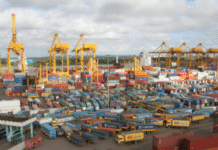In an exclusive interview with Dhaka Tribune’s Shariful Islam at the CPA headquarters in Chittagong, CPA Member for Administration and Planning Md Zafar talks about how the CPA can tackle the issue by shifting container unloading outside the port area.
The country’s prime seaport in Chittagong has been operating without any new infrastructure for almost a decade. The volume of the port’s container handling has doubled during the period; from 1 million in 2009 to 2.5 million in 2017.
The Chittagong Port Authority (CPA) has been struggling to cope with the challenge of container handling growth. Developing new infrastructure for the port operation will take around eight to ten years. But an immediate solution is necessary.
The CPA has handled more than 2.56 milion TEUS of containers in the last year. The number of containers was around 1million in 2009. During this period no new infrastructure had been developed at the port. So how are you managing the growth now, and what is the future plan?
We are now facing the challenge of maintaining the growth rate. It is not like a new port has been developed during the last decade. We have tackled the growth of containers with the existing infrastructure. The growth in the amount of containers is basically related with the greater expansion of our economy over the years.
We have found in our study that we would need around 10 years to build a new port. That is why we have taken short, medium and long-term plans for the port development including various projects and a master-plan.
What types of projects have you undertaken to develop the port’s infrastructure?
We have already started different projects according to the 2013 master plan. There are some projects beyond the master plan like the Bay Terminal and the Matarbari Port project.
The Matarbari sea port, 50 kilometers away from the Chittagong port, has huge potential to become a commercial port. The port’s channel with 250 metre width and 16 metre height (could be raised to 18 metre), would be deep enough to host the largest container vessels, which is scheduled to be completed by 2023.
The construction of Patenga Container Terminal, Laldia Multipurpose Terminal is underway. We have also planned to construct a jetty at the Mirsarai, where the largest economic zone is being developed.
The Patenga Container Terminal project is underway under the supervision of Bangladesh Army, which is scheduled to be handed over to the port by 2019.
Besides, the four jetties at Karnaphuli Terminal built during the British period will be rebuilt with Asian Development Bank (ADB) funds. Bangladesh Army will implement the project by 2019.
The businesses are saying the Bay Terminal project could have potential because of its location and there is a channel where a mother vessel of 50,000 tons could easily be accommodated. But, the progress of building the terminal is slow. What is the latest progress of the project?
The Bay Terminal is a fast track project, where we will build a 1,750 metre multi-purpose terminal and a 1,100 metre container terminal with back up facilities and a breakwater. The first phase of the bay terminal project is supposed to be completed by 2021.
The tender for 1,000 metre multi-purpose terminal has already been floated under the public and private partnership (PPP). We are now acquiring land for building the container terminal and initially we have planned to install a container freight station to mitigate the pressure on the existing container-yards.
There is also an acute crisis of equipments including gantry crane at the port. There are four gantry cranes at the port; two of them have been out of operation for the last six months. What about the progress of purchasing new gantry cranes?
The present condition of equipments at the Chittagong port is better than previous years. We have already approved procurement of equipment for the new mooring container terminal of Chittagong port.
During last fiscal year, 2016-17, we have bought 46 pieces of equipment including three Rubber-tiered Gantry Cranes (RTGs) for container handling facility, while we have planned to purchase 251 categories of equipment by this fiscal year.
We have ordered six new gantry cranes, which are scheduled to be added with the port’s equipments by next year.
What are the reasons behind containers congestion at the port?
This is a very good question. There is a misconception among people that the port authority is solely responsible for the container congestion at the port. The port is just a platform, where there are many factors including the importers, exporters, the Water Transport Cell, Clearing and Forwarding Agents, Shipping Agents, Customs, Department of Environment, and others. A congestion-free port cannot be achieved without support and cooperation from all stakeholders.
The port’s duty is to handle containers, which should take 72 hours at highest, while we are giving 96 hours to take the container outside the port. The main reason behind the container congestion is that the customs formalities are done inside the port area. Such a method is not in practice at any other port across the world. Container unstuffing inside the port premises causes container congestion as well as revenue loss.
How do you plan on solving this problem?
The Customs formalities must be done outside the port premises. In this regard, the National Board of Revenue (NBR) might establish more container freight stations (CFSs) or inland container depots (ICDs), and the number of private off-dock could be increased as well. The NBR could also increase the handling of import containers of selected 70 items instead of 37 low-duty items at the ICDs.
Moreover, around 10 years will be needed to complete building new infrastructure for expediting port operation; we have to cope up with the challenge of container handling growth with low-cost solution for now. That’s why container unstuffing must be shifted outside the port area. Once that is done, the CPA could handle the growth of container handling for the next five to seven years without any tension.
There has been a rising concerns among ship owners, charterers, shipping agents and other stakeholders that the ships have frequently been colliding with each other and running aground at the port’s outer anchorage. What steps are you taking to address the problem?
The port channel has high traffic. Every day around 3,000-3,500 vessels move through the channel and this is a big challenge for us to maintain the safe vessel movement using tags. The pressure from heavy traffic is one of the main reasons for the accidents. The channel is the lifeline of the port; if the channel is damaged by any accident it would paralyze the whole economy of the country. That’s why we are always concerned about the channel. With a view to avoid the accidents, we are upgrading the regulation on safe navigation in the area for the masters.
Source: Dhaka Tribune.










